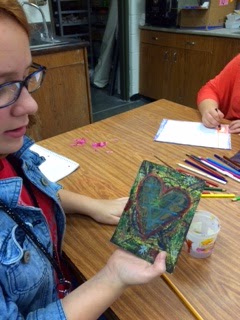"Let's just see what happens." says one of my 8th grade boys to his tablemates as he dips one his experimental mini lesson samples into the dirty water container.
The new National Core Art Standards are intentional about encouraging students to take creative risks, experimenting with both ideas and materials.
Before we begin each art problem, my student will have a few
days in preparation talking and sketching about ideas they can use to approach
the problem and they play with different media that they might want to explore
further in their final piece. In the photo above, my students are experimenting
"painting without paint" and are creating mini samples on budget watercolor
paper with coffee, different flavors of tea, dried out marker foam inserts that
had been soaking in warm water, koolaid flavors, and tissue paper that bleeds.
They applied the media with the tea bags, straws and even their fingers.
 The
next day, we worked back into the samples with fine tip sharpies, watercolor
pencils and watercolor crayons. In two days time, the students are introduced
to a wealth of art making strategies that they can have in their toolbox for
future use as they so choose. Making the samples is important as it helps
encourage risk taking. They can play with their ideas in a smaller, less risky
place and if it doesn't work, they discover that it's ok, really. They can try something new and just see
what happens. In the photo to the right, the students are spending just a few minutes of a few class periods thinking about their ideas in new ways; in example, how could they apply their idea as a diorama, as a sculpture, as a painting, as part of a series of works, by incorporating an older peice of work made in class, etc. I've found that it's helpful to stretch the planning time for a problem over a few days in smaller chunks rather than doing all of the planning in one full class period. Their ideas are richer, they seem more engaged in the lanning process, and they actually spend more time thinking about their work in new ways (growing creatively), in the long run.
The
next day, we worked back into the samples with fine tip sharpies, watercolor
pencils and watercolor crayons. In two days time, the students are introduced
to a wealth of art making strategies that they can have in their toolbox for
future use as they so choose. Making the samples is important as it helps
encourage risk taking. They can play with their ideas in a smaller, less risky
place and if it doesn't work, they discover that it's ok, really. They can try something new and just see
what happens. In the photo to the right, the students are spending just a few minutes of a few class periods thinking about their ideas in new ways; in example, how could they apply their idea as a diorama, as a sculpture, as a painting, as part of a series of works, by incorporating an older peice of work made in class, etc. I've found that it's helpful to stretch the planning time for a problem over a few days in smaller chunks rather than doing all of the planning in one full class period. Their ideas are richer, they seem more engaged in the lanning process, and they actually spend more time thinking about their work in new ways (growing creatively), in the long run..jpg)


No comments:
Post a Comment